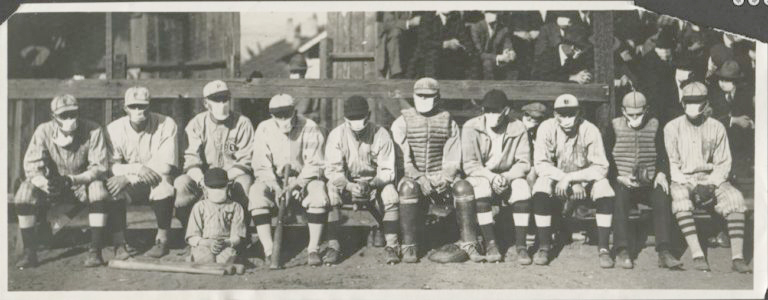With professional, college and high school seasons upon us, I wondered how the last great pandemic affected the sports world a century ago; there are many similarities to our current plight. The Spanish Flu hit America in March of 1918 and although it was called the “Spanish Flu”, the first known case was on an army base in Kansas. The global spread was due primarily to the transport and travel associated with World War I.
The outbreak claimed between 50-100 million lives worldwide. A total of 500 million people became infected – one third of the world’s population at that time. Baseball was the most popular sport in that day, and the owners decided to play on because of financial reasons. After a handful of deaths among players and umpires, many wore masks even on the field. The Boston Red Sox were hit particularly hard during spring training, including pitcher Babe Ruth. During that time, Ruth pitched fewer games and played more often in the field that year because of the lingering affects of the virus. As a result, he hit a league leading 11 homeruns. He had hit only nine in his previous four seasons in the league. The move to the outfield became permanent.
Due to the lack of major league players because of the war and the pandemic, the season was cut short by a month. The Red Sox defeated the Chicago Cubs in the World Series; however, Ruth was infected a second time soon after the final game. Many historians attribute that series for starting the second, deadlier wave of the pandemic. After those games, five thousand people died of the flu in Boston. The NHL was in its second year, and the Montreal Canadiens met the Seattle Metropolitans in the Stanley Cup Finals. With the series tied 2-2, the Canadiens were forced to cancel after they were ravaged by an outbreak. Defenseman Joe Hall died only days after contracting the virus. The Metropolitans refused to accept a forfeit, and the champions’ spot on Lord Stanley’s cup remains blank for that year. The NFL did not yet exist, but the colleges tried to piece together a delayed and abbreviated football season with small mask wearing crowds in attendance. No national champion was crowned that year because so many teams canceled key games. It would have been impossible to determine the best team based on such schedules.
Locally, both Waynesburg High School and College did not field football teams because of the war and the pandemic. Moreover, the high school had an abbreviated season the year before because of a quarantine due to an outbreak of infantile paralysis. There were no baseball games recorded in the county that spring or summer. How-ever, it appears the high school and college both participated in basketball. The high school’s season started in late January of 1919 and ended March 29. The Little Jackets (as they were called at the time) concluded their campaign by winning the Canonsburg Tournament after defeating Claysville, Crafton and Washington High Schools. The Yellow Jackets were coached by Professor Paul “Prexie” Stewart, who had been charged with bringing sports back to the college after the war. By the summer of 1919, the pandemic had subsided as people either succumbed or developed immunity to the virus.
Few people remember the Asian Flu pandemic of 1957. That outbreak killed 2 million people worldwide, including over 75,000 Americans. The peak of the first wave in the U.S. hit the second week of October, not long after students had returned to school. The WPIAL canceled all football games that weekend. The season resumed the following week for most schools. While there are many opinions regarding the resumption of our normal lives in these historic times, there are no easy answers in a pandemic. It may help in some small way to look at the past and learn from our mistakes and successes.
